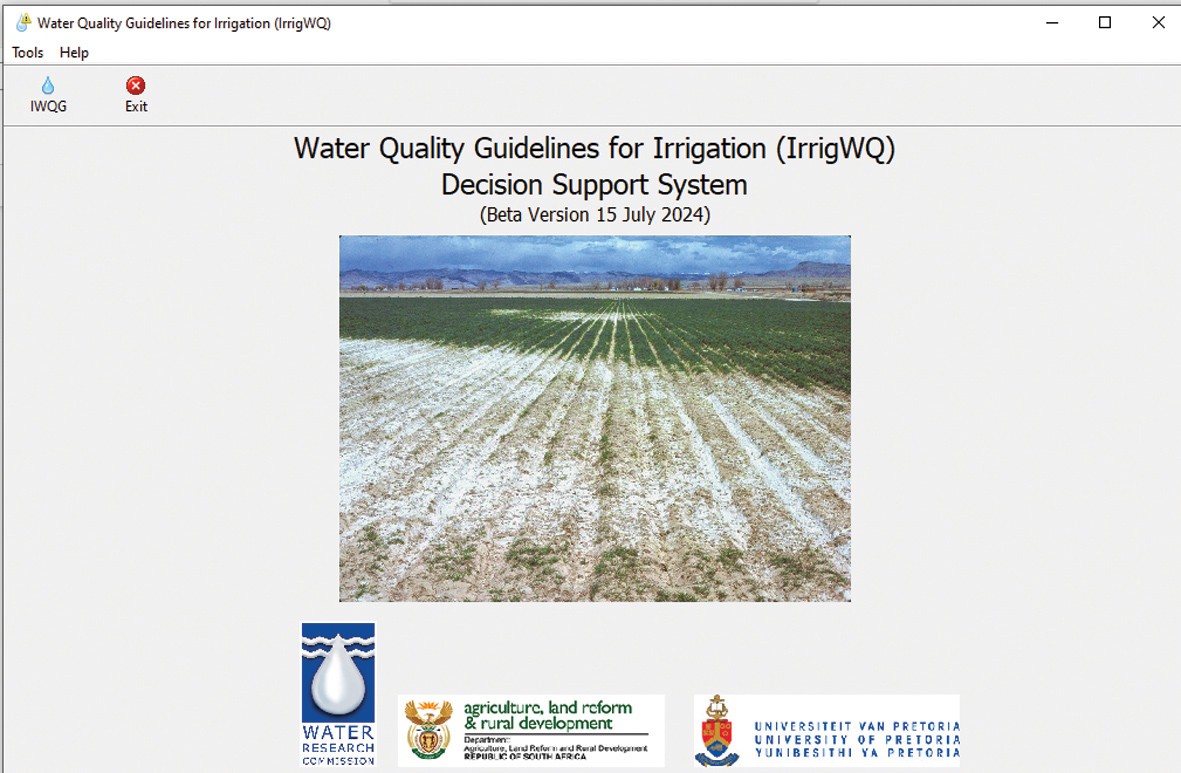

Prof John Annandale, University of Pretoria

Dr Nico Benade,
NB Systems
 Lesego Madiseng, University of Pretoria
Lesego Madiseng, University of PretoriaBefore embarking on any irrigation development and at regular intervals afterwards, it is prudent to determine the fitness of the water source for irrigation, in order to pro-actively identify and circumvent potential water quality-induced problems.
Several classification systems have been developed to assess the suitability of water for irrigation. Arguably the best known of these is the system published by the US Salinity Laboratory Staff in 1954. They identified salinity (which affects crop yield) and sodicity (which affects soil permeability) as the most important components determining the suitability of water for irrigation purposes. Subsequently, several guidelines which consider a much larger range of water quality constituents and their effects have been published.
Recently the University of Pretoria, with financial assistance from the South African Water Research Commission and the Department of Agriculture, developed a computer programme called IrrigWQ, with which to assess the fitness for use of irrigation water (Du Plessis et al., 2017). IrrigWQ predicts the consequences that are likely to arise when a specific water is used for irrigation and thus provides a user with support to select the best way to use this water source. The guidance provided by IrrigWQ differs in several fundamental ways from earlier guidelines. Not only are they risk-based, but they also allow for much greater site specificity and are available primarily as a software-based decision support system (DSS).
The software can be downloaded free of charge from the NB Systems website. To utilise the DSS, it is necessary to enter the water analysis results and site-specific characteristics, like crop choice, climate, irrigation method, and water management. The DSS will then calculate the effect the water composition is expected to have on indicators of soil quality, crop yield and quality, and irrigation equipment.
Water quality constituents and suitability indicators
IrrigWQ assesses the fitness of a given water for irrigation from the concentrations of eight major constituents, two biological constituents, three nutrients and twenty trace elements. Constituents are evaluated for the effect they have on soil quality, crop yield and quality, and irrigation equipment. At least the concentrations of the major constituents are required in order to conduct a fitness-for-use assessment. While analyses for other constituents are not mandatory, their effect on fitness for use will only be assessed if analyses are provided.
Effect of water quality constituents on soil quality
The impact irrigation water constituents have on soil quality are primarily indirect, as a result of the interaction between the water quality constituents and soil components. This interaction is modified by the fact that soil also acts as a temporary store of water for plant use, and that crops extract almost pure water, leaving most of the water quality constituents in the soil. The degree to which these constituents accumulate in soil and interact with soil components, determines how water quality constituents affect soil quality. The DSS considers the following suitability indicators to assess the effects irrigation water constituents have on soil quality:
- root zone salinity
- soil permeability
- oxidisable carbon loading
- trace element accumulation
Effect of water quality constituents on crop yield and quality
The impact irrigation water constituents have on crop yield and quality are both direct and indirect. Direct contact of irrigation water with a crop mostly affects crop quality, while indirect impacts mostly affect crop yield. Indirect impacts are a consequence of the accumulation and redistribution of irrigation water constituents within the root zone. The DSS considers the following suitability indicators to assess the effects irrigation water constituents have on crop yield and quality:
- root zone effects of salinity, B (boron), Cl (chloride) and Na (sodium) on yield
- leaf scorching when wetted
- contribution to NPK (nitrogen, phosphorus, and potassium) uptake by the crop
- microbial contamination
- qualitative crop damage by atrazine

Effect of water quality constituents on irrigation equipment
The impact irrigation water constituents have on irrigation infrastructure to distribute and apply water, is a direct result of the interaction between water quality constituents and irrigation equipment. This interaction is determined primarily by the material irrigation equipment is made of, or the type of irrigation system used. The DSS considers the following suitability indicators to assess the effects irrigation water constituents have on irrigation equipment:
- corrosion or scaling of irrigation equipment
- clogging of drippers
Display of IrrigWQ output
Results of the water quality assessment are reported using four colour-coded fitness-for-use categories to report the increasing risk associated with using the water, as indicated in tables. Results reported against a blue background indicate a very low risk associated with using the water for its intended purpose, while a red background indicates an unacceptable risk (Table 1).

Calculating procedures
In addition to providing the water composition, users also need to specify site-specific conditions, such as irrigated crop, site-specific climatic conditions, whether a surface or overhead irrigation system is to be used, how irrigation applications are to be managed, and the texture of the irrigated soil. It is important to consider these variables as they determine soil-plant-atmosphere interactions. Changes in management practices may reduce or overcome the effects of specific water quality problems.
Water requirements and uptake of the user-selected crop is calculated using a simplified version of the dynamic Soil Water Balance (SWB) model that is run for a minimum of ten years using data from an appropriate weather station. SWB also simulates transient salt transport and simplified soil chemical interactions. The output from these simulations is used to calculate the seasonal values of the different suitability indicators of soil quality, crop yield and quality, and irrigation equipment.
IrrigWQ output
Table 2 presents an example of how IrrigWQ can be used to provide guidance on crop selection when water of a specific composition is available. Crop yield is the main suitability indicator that is considered when irrigation with a saline water is envisaged. The table summarises the variability in crop yield predicted by IrrigWQ over a 40-year period applying a moderately saline water.

Crops were irrigated to field capacity with a 150 mS/m water, whenever the accumulated water deficit exceeded 30% of plant-available water. Crops should thus not have experienced any water stress. Climate and crop are the only two variables considered in the table. The differences in predicted crop yield can be explained by soybean being more salt tolerant than maize and the increasingly more humid climate that results in more dilution of the saline irrigation water by rain, amplified by a larger leaching fraction.
It is clear that neither crop would do well under the simulated conditions at the very arid Upington site (163 mm annual rainfall). Maize yield at Vaalharts, with around three times as much rainfall as Upington, would be much improved, but a yield penalty is still expected with only seven out of ten years expected to give top yields. On the other hand, no yield loss is expected for soybean with this water in Vaalharts. At Delmas (>700 mm rainfall), both maize and soybean are predicted to suffer no yield loss when irrigated with this water. In practice, more simulations would be run to investigate whether there are management conditions under which yield can be improved. By increasing the amount of water applied and thus the leaching fraction, it would, for example, be possible to reduce the soil profile salinity and increase crop yield at Upington. This example illustrates nicely how important it is to take site-specific factors into account when assessing irrigation water quality.
Conclusions
The DSS described in this article provides the user with site-specific assessments of how a water of a given composition will affect soil quality, crop yield and quality, as well as irrigation equipment. A range of suitability indicators were identified for this purpose. Criteria have been established for each suitability indicator, enabling an assessment of the effect that the water composition could have on the suitability indicator. This effect is categorised as being ideal, acceptable, tolerable, or unacceptable.
Reference
Du Plessis M, Annandale J, Benade N, Van der Laan M, Jooste S, Du Preez C, Barnard J, Rodda N, Dabrowski J, Genthe B & Nel P. 2017. Risk based, site-specific, irrigation water quality guidelines: Volume 1, Description of Decision Support System. WRC Report No.TT 728/17. Water Research Commission, Pretoria



























